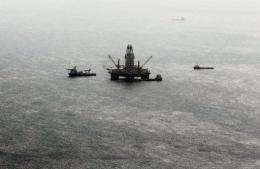Preparations for BP well 'kill' operation move ahead

Engineers moved ahead on Sunday with preparations for a well "kill" operation that officials hope will permanently plug the oil leak causing the worst US environmental disaster.
A major vessel charged with drilling a relief well to finally stop the BP oil spill arrived back at the Gulf of Mexico well site on Saturday after briefly evacuating due to a tropical storm.
US Coast Guard Admiral Thad Allen said the first chance to seal the well for good could come in the next few days, as response crews quickly scaled operations back up after the storm fizzled.
"That is a very rough estimate, three to five days from now," Allen said.
The returning drill rig, Development Driller 3 (DD3), was among some 10 ships that evacuated the area ahead of Tropical Storm Bonnie. It was to begin reattaching to the well site immediately, according to the US official overseeing the spill response.
A cap over the wellhead has shut in leaking oil since July 15.
But officials and residents are desperate to permanently resolve the disaster, more than three months after the April 20 explosion aboard the BP-leased Deepwater Horizon oil platform which killed 11 workers and sank the rig.
The International Energy Agency estimates that between 2.3 million and 4.5 million barrels of crude have gushed into the sea as a result of the leak.
A spokesman for the British energy giant, Bryan Ferguson, said it would take around 21 hours to reconnect the DD3 to drilling operations some 5,000 feet (1,500 meters) below the sea surface.
The rig is drilling the first of two relief wells that will be used to definitively plug the devastating spill.
BP and US officials currently plan two operations to kill the well.
The first, a "static kill," involves pumping heavy drilling fluid known as mud through the blowout preventer valve system that sits on top of the well, and then injecting cement to seal it.
The process is similar to a "top kill" attempt that failed in May, but officials say the cap now in place over the leak will make the operation easier and more likely to succeed.
However, BP and US responders have said the ultimate solution to the leak will be via the relief wells, which will intersect the original well.
Using the same process as the static kill, drilling fluid, which is denser than oil, will be pumped via the relief well until the flow of crude is overcome, allowing the damaged well to be sealed with cement.
Before either can begin, the last section of the relief well must be secured with a 3,000-foot piece of steel pipe called a "casing run", which will be cemented in place.
"You're probably into three to five days from now when they might be able to be in a position to have the casing pipe in place and we could probably start the static kill at that point," Allen said.
However, the announcement came amid media reports that BP's boss, Tony Hayward, was poised to quit within days.
The Sunday Telegraph newspaper reported Hayward, who has been heavily criticized over his handling of the oil spill crisis, was set to step down before BP announces its half-year results on Tuesday.
BP has said that Hayward "has the support of the board and management" but has declined to further comment on the reports.
The spill has now washed up oil along the shorelines of all five US states on the Gulf Coast. But amid Saturday's high anxiety over the storm and the evacuation of vessels that aimed to keep workers and equipment safe, some experts said the high waves kicked up by Bonnie might actually help dissolve some of the oil faster.
Other experts argue that surface currents bolstered by high winds would likely shift the near-surface oil closer to the Gulf Coast and spread it over a larger area, and that a severe storm surge from the likes of a hurricane could send fouled water far up into the bayous, contaminating fragile spawning grounds for fish and shrimp.
In Larose, a Louisiana town near the Mississippi River delta, a shrimper named Barry who now does spill cleanup work for BP said Gulf Coast residents dodged a bullet when Bonnie fizzled.
"If we can get lucky and just have Bonnies, we would fare a lot better," he told AFP.
"A hurricane anything more than minimal size, even a big tropical storm, is going to be devastating to this entire area."
(c) 2010 AFP



















